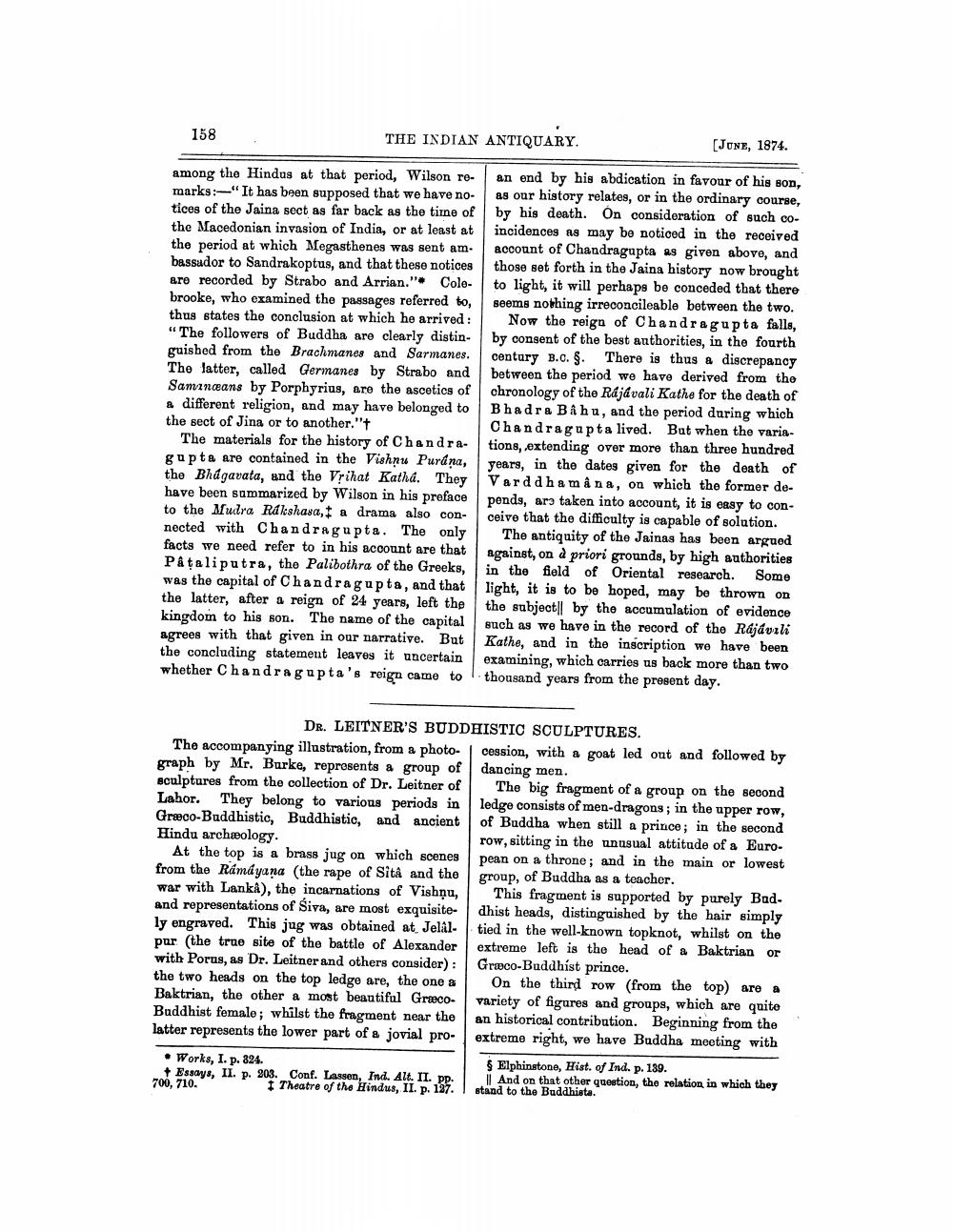________________
158
THE INDIAN ANTIQUARY.
among the Hindus at that period, Wilson remarks:-"It has been supposed that we have notices of the Jaina sect as far back as the time of the Macedonian invasion of India, or at least at the period at which Megasthenes was sent am. bassador to Sandrakoptus, and that these notices are recorded by Strabo and Arrian." Colebrooke, who examined the passages referred to, thus states the conclusion at which he arrived: "The followers of Buddha are clearly distinguished from the Brachmanes and Sarmanes. The latter, called Germanes by Strabo and Samanæans by Porphyrius, are the ascetics of a different religion, and may have belonged to the sect of Jina or to another."+
The materials for the history of Chandragupta are contained in the Vishnu Purána, the Bhagavata, and the Vṛihat Katha. They have been summarized by Wilson in his preface to the Mudra Rakshasa, a drama also connected with Chandragupta. The only facts we need refer to in his account are that Pâtaliputra, the Palibothra of the Greeks, was the capital of Chandragupta, and that the latter, after a reign of 24 years, left the kingdom to his son. The name of the capital agrees with that given in our narrative. But the concluding statement leaves it uncertain whether Chandragupta's reign came to
DR. LEITNER'S BUDDHISTIC SCULPTURES.
The accompanying illustration, from a photo- | graph by Mr. Burke, represents a group of sculptures from the collection of Dr. Leitner of Lahor. They belong to various periods in Græco-Buddhistic, Buddhistic, and ancient Hindu archæology.
At the top is a brass jug on which scenes from the Rámáyana (the rape of Sitâ and the war with Lanka), the incarnations of Vishnu, and representations of Śiva, are most exquisitely engraved. This jug was obtained at Jelâlpur (the true site of the battle of Alexander with Porus, as Dr. Leitner and others consider): the two heads on the top ledge are, the one a Baktrian, the other a most beautiful GræcoBuddhist female; whilst the fragment near the latter represents the lower part of a jovial pro
[JUNE, 1874.
an end by his abdication in favour of his son, as our history relates, or in the ordinary course, by his death. On consideration of such coincidences as may be noticed in the received account of Chandragupta as given above, and those set forth in the Jaina history now brought to light, it will perhaps be conceded that there seems nothing irreconcileable between the two.
Now the reign of Chandragupta falls, by consent of the best authorities, in the fourth century B.C. §. There is thus a discrepancy between the period we have derived from the chronology of the Rájávali Kathe for the death of Bhadra Bahu, and the period during which Chandragupta lived. But when the variations, extending over more than three hundred years, in the dates given for the death of Varddhamâna, on which the former depends, are taken into account, it is easy to conceive that the difficulty is capable of solution.
Some
The antiquity of the Jainas has been argued against, on à priori grounds, by high authorities in the field of Oriental research. light, it is to be hoped, may be thrown on the subject by the accumulation of evidence such as we have in the record of the Rájávili Kathe, and in the inscription we have been examining, which carries us back more than two thousand years from the present day.
Works, I. p. 324.
+ Essays, II. p. 203. Conf. Lassen, Ind. Alt. II. pp. 700, 710. I Theatre of the Hindus, II. p. 127.
cession, with a goat led out and followed by dancing men.
The big fragment of a group on the second ledge consists of men-dragons; in the upper row, of Buddha when still a prince; in the second row, sitting in the unusual attitude of a European on a throne; and in the main or lowest group, of Buddha as a teacher.
This fragment is supported by purely Baddhist heads, distinguished by the hair simply tied in the well-known topknot, whilst on the extreme left is the head of a Baktrian or Græco-Buddhist prince.
On the third row (from the top) are a variety of figures and groups, which are quite an historical contribution. Beginning from the extreme right, we have Buddha meeting with
§ Elphinstone, Hist. of Ind. p. 139.
And on that other question, the relation in which they stand to the Buddhists.




